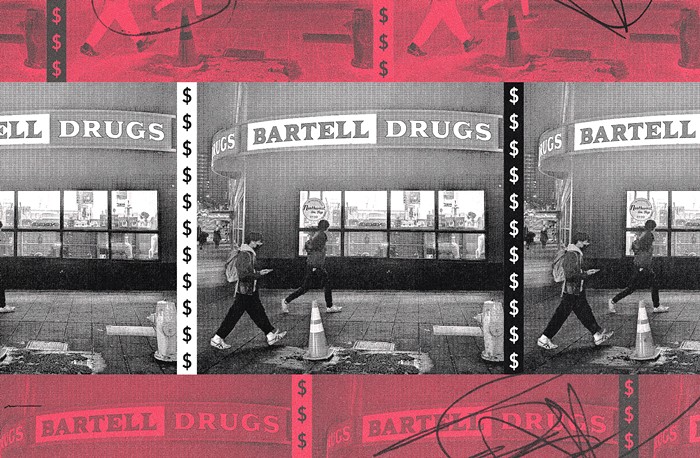
It opened exactly 100 years ago today. Back then, we are told, it was a state-of-the-art cinema palace named the U-Neptune Theatre. It had “public telephone rooms,” writes Seattle Times' Moira Macdonald, who brings back a number of forgotten memories in her precious post. The stained-glass depictions of sea mythologies were not, in fact, made of glass but plastic, points out MyNorthwest. And this makes them even more special. Hard to find fake stained glass today. KING 5 offers a history of the theater that doesn't fail to remind viewers of the Seattle record the theater broke back in the day: It screened "the cult classic 'Rocky Horror Picture Show'... every week for 14 years."
In the first decade of this century, there was talk of demolishing the whole damn thing. In 2011, the events business the Seattle Theatre Group bought the place and spent an impressive $720,000 pulling it from the void and transforming it into a venue for live shows. The very last movie to screen in the ruins of the cinema palace was the Green Hornet.
In 1994, I watched Andrei Tarkovsky's The Sacrifice at the Neptune. I think there were a total of five of us in that cavernous space that night, and I knew two of them, Keith and Amy (they were on a date). The movie changed my life. Tarkovsky fast became my favorite filmmaker, which only enhanced the respect I already had for early 20th century Russian literature. The theater, however, did nothing for me, which was not true of, say, the Seven Gables (magical) or the Harvard Exit (cozy), both of which are, physically speaking, no longer with us. The Neptune is, and I think this is why Seattle's press is pouring so much bubbly love into the building.
To commemorate the 100th anniversary of Seattle's Neptune Theatre on Nov. 16, we've compiled some of our readers' memories and photos of this historical University District venue. Here are your stories! https://t.co/1QNjeuF9g9
— The Seattle Times (@seattletimes) November 11, 2021
Moira Macdonald:
According to research presented to the Landmarks Preservation Board in 2012 (which granted Seattle landmark status to the building), the Neptune was one of five cinemas that opened in the neighborhood during the silent film era, and is the only (mostly) intact survivor.
Being around for a century demands respect and celebration in a city that tears down its past without so much of a thought. This was there. This is no longer there. Or was it there in the first place? This is almost the experience of any walk taken in a city that rose to international recognition only a decade or so ago. And haven't you heard of Vanishing Seattle? Location loss has achieved the status of a religion in this brand new-looking city.

I've watched excellent events in the post-2011 Neptune. One was Hari Kondabolu's 2018 comedy set for Netflix, Warn Your Relatives. Another was Industrial Revelation's 2017 performance of Bjork's masterpiece album Homogenic. And in 2014, I watched the Black Constellation extravaganza here (ft. Shabazz Palaces, Chimurenga Renaissance, THEE Satisfaction) on the last night of 2014. The feelings I had when watching movies in the Neptune in the 1990s were about the same as those I experienced during live shows in the second decade of the new century. The space just does not move me.
Indeed, if the Neptune had been reduced to a pile of rubble like the old Capitol Hill funeral home that was the Hugo House for nearly two decades or the University District's faux-gothic University Temple United Methodist Church, I would not have "moaned and moved on." I would just have moved on. Seattle does not have much of a past. I can live with that.















